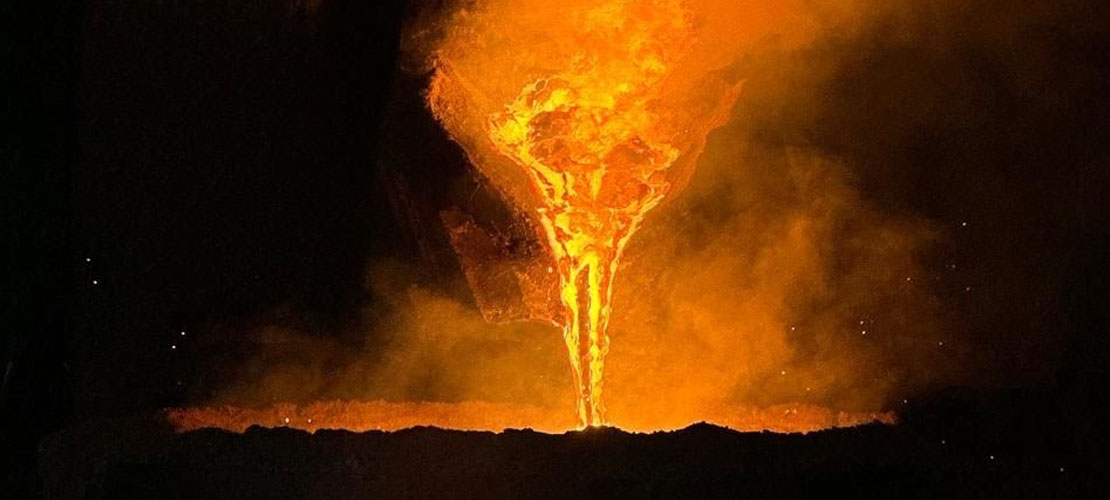Nov. 10, 2025

The tapping temperature not only affects electricity consumption but also directly impacts product quality. Excessive tapping temperature wastes electricity, affects the surface quality of the ingot, and may even cause the die to melt.
Sometimes, to bring the tapping temperature down to the required level, it's necessary to cool the furnace, which prolongs smelting time and increases the gas and inclusion content in the molten steel. Conversely, if the tapping temperature is too low, forced pouring results in a poor ingot surface; sometimes, the molten steel level stops rising halfway through pouring, overflowing from the pouring pipe and rendering the entire furnace unusable. Sometimes, this is done to avoid producing defective products.
Often, when the temperature is found to be too low after tapping, the steel is forced to be returned to the furnace and reheated. This not only does nothing to improve steel quality but also wastes a significant amount of electricity.
From the above, it is clear that properly managing the tapping temperature plays a role in saving electricity. So how can we properly manage the tapping temperature? Controlling the tapping temperature is not an easy task. Steelworkers must pay attention to every key step in the entire smelting process to ensure a smooth process for each batch of steel and ultimately achieve the tapping temperature meets the process specifications.
Due to the influence of factors such as the furnace and transformer, each batch of steel has its optimal power characteristic curve. If the voltage and current are not consistently high or low, the power cannot be fully utilized, and high voltage and high current will inevitably lead to power waste.
When powering through the furnace, a relatively small voltage and current are generally applied because the furnace charge is high and full, the arc is at the top of the furnace, and the charge is very close to the furnace cover. If a large voltage and high current are used, the arc length will be large, and the radiation will be strong, which will not only seriously damage the furnace cover but also result in significant heat loss. The three electrode holes will then become heat dissipation chimneys.
Once the well has reached the bottom and the electrodes are embedded in the furnace charge, applying high current and voltage is reasonable because the arc light is completely surrounded by the charge, and most of the heat is absorbed by the charge, accelerating melting.
After most of the charge has melted, the voltage and current should be appropriately reduced as the molten pool forms. High voltage and current at this stage, coupled with intense arc radiation, will erode the furnace walls and lid, reducing their lifespan and creating difficulties in smelting.
High current is generally used during the oxidation period to create high-temperature oxidation boiling conditions. At the end of the oxidation process, the temperature before slag removal is typically ≥20°C higher than the tapping temperature. However, the reduction period tends to gradually decrease in temperature, considering the need for slag removal and the creation of new slag.
The process specifications stipulate temperature requirements for each critical stage. Strictly adhering to these requirements is crucial for achieving the correct tapping temperature.
Before oxidation-reduction or tapping, we must conduct temperature measurements to ensure a reasonable tapping temperature is reached.
The impact of tapping methods: During tapping, the temperature generally drops by 20-50℃.
Correctly judging the molten steel temperature during tapping is also an aspect of energy conservation. From actual production, we know that the temperature drop during tapping is related to factors such as the size of the tapping spout, the length of the tapping trough, the degree of ladle baking, the amount of molten steel, and the characteristics of the steel flow.
To save energy, we must rationally control the tapping temperature. Through the steelworker's understanding of the entire process and in conjunction with temperature measuring equipment, we can correctly grasp the temperature situation. At the same time, we must follow the correct tapping method to ensure that the slag is discharged simultaneously, minimizing the temperature drop during tapping.
In production, the actual amount of steel tapped is also a factor affecting temperature drop. Under the same conditions, a larger amount of molten steel results in slower heat dissipation, while a smaller amount results in faster heat dissipation.
Normal ladle baking results in less heat dissipation, while abnormal baking or a cold ladle results in faster heat dissipation and a more severe temperature drop. A reasonable tapping temperature is essential to ensure a reasonable pouring temperature.
Tapping temperature = Solidification temperature + Tapping and cooling + Superheat
Solidification temperature: Varies depending on the steel composition, but for a given steel composition and grade, it is a fixed value.
Superheat: Determined to ensure sufficient fluidity of the molten steel during pouring; superheat also significantly affects pouring quality.
If slag and steel are tapped simultaneously, and the ladle is properly preheated, heat dissipation is minimal, and the tapping temperature can be lowered accordingly.
Latest News
Refractory for Ferrosilicon Furnace
Nov. 11, 2025
Why is It Important to Properly Control the Tapping Temperature?
Nov. 10, 2025
Latest Products
Customized metallurgical machinery and equipment range: Electric Arc Furnace, Submerged Arc Furnace, LF Refining Furnace, Vacuum Furnace, Induction Furnace, Dust Remove System, Water Treatment Equipment, etc. Providing the most advanced equipment integration services, metallurgical equipment can be customized according to different needs of customers, and production capacity can be adjusted according to customer requirements.
Electric Arc Furnace
Submerged Arc Furnace
LF Refining Furnace
VD / VOD Vacuum Refining Furnace
Induction Furnace
Furnace Accessories
Navigation
E-mail: anna@srfurnace.com
Tel: +86 159 2955 5868
WhatsApp: +86 159 2955 5868
Add:
Room 422, 4th Floor, Building D, No. 5, Phase I, Fengdong Free Trade Industrial Park, Xixian New District, Shaanxi Province
